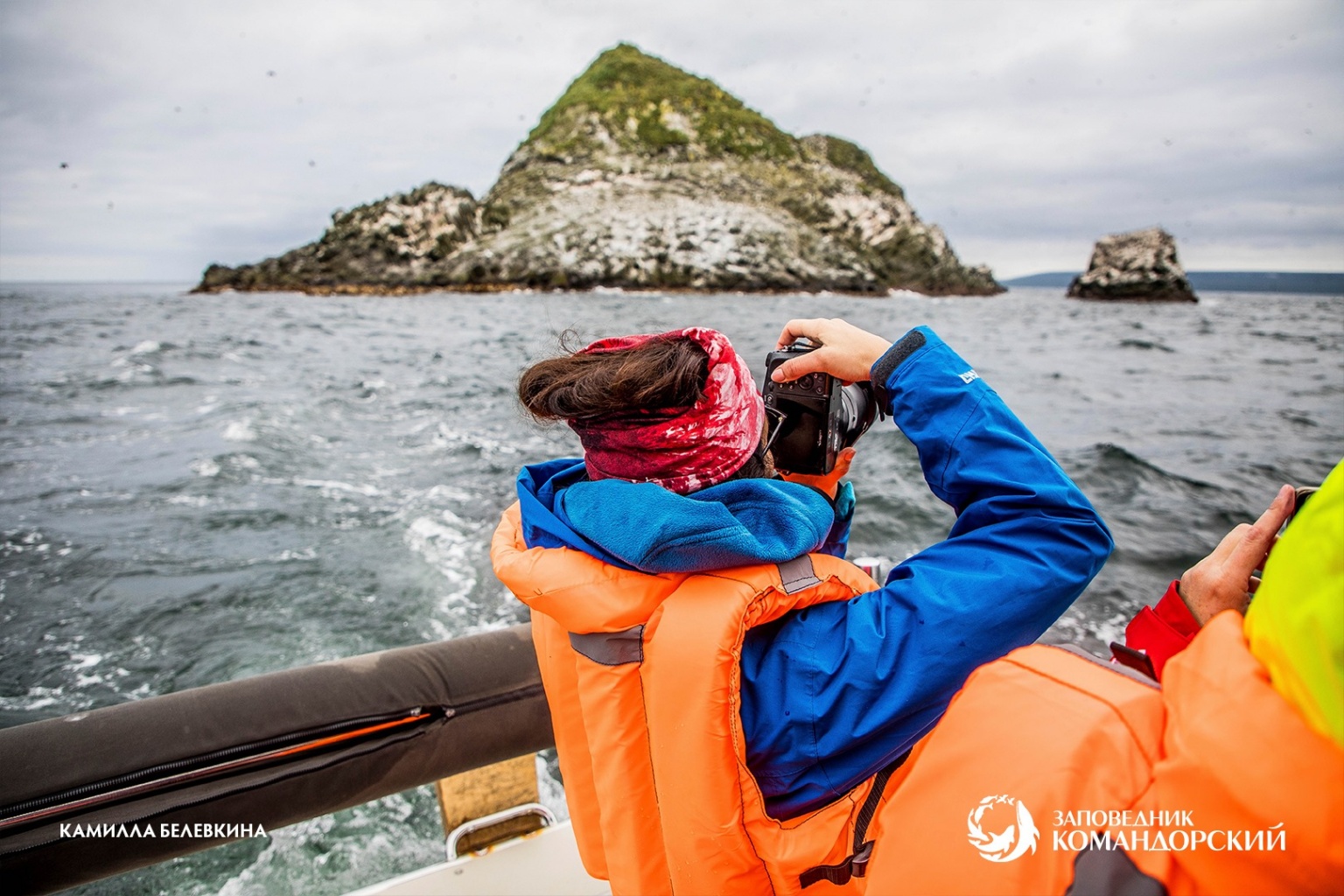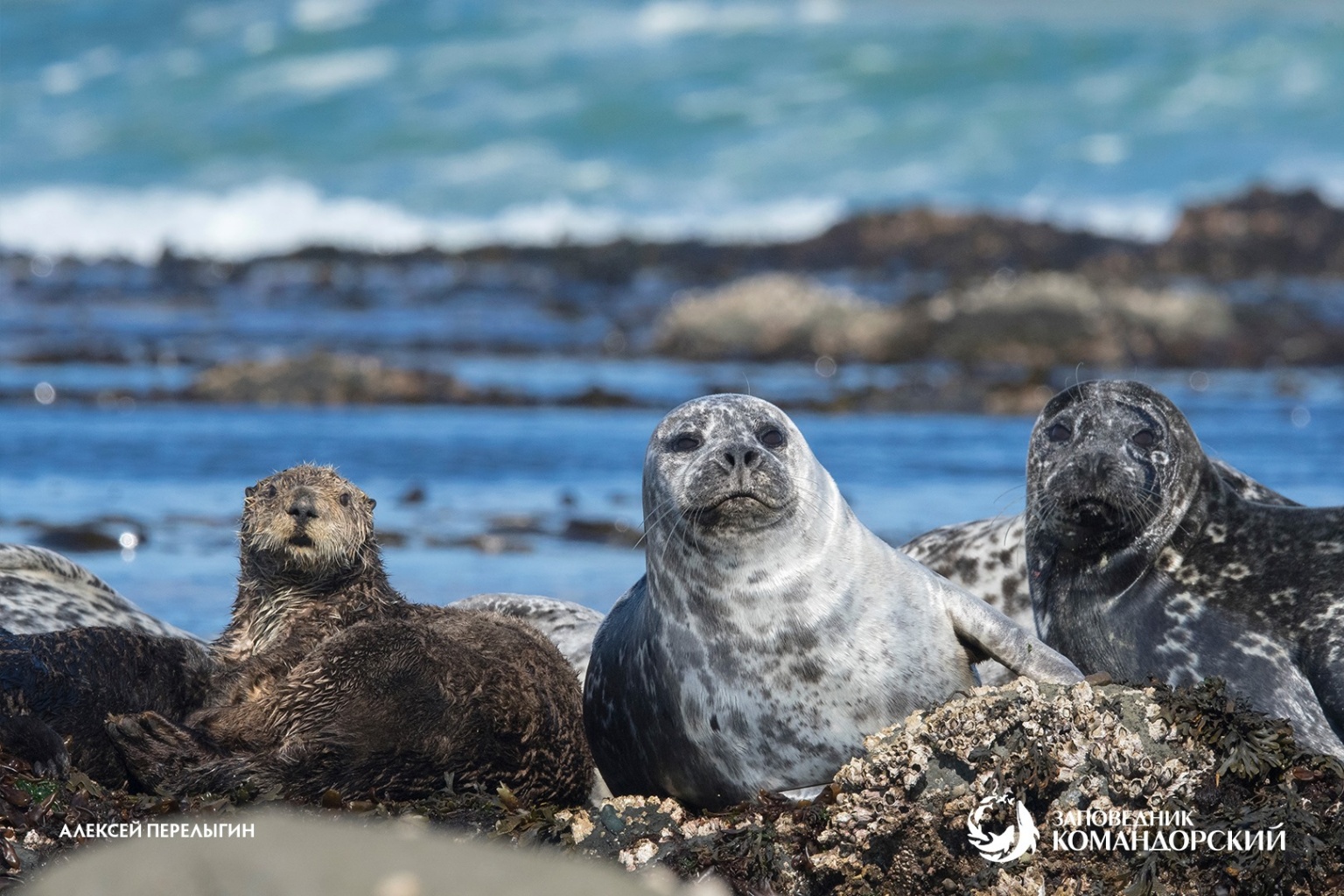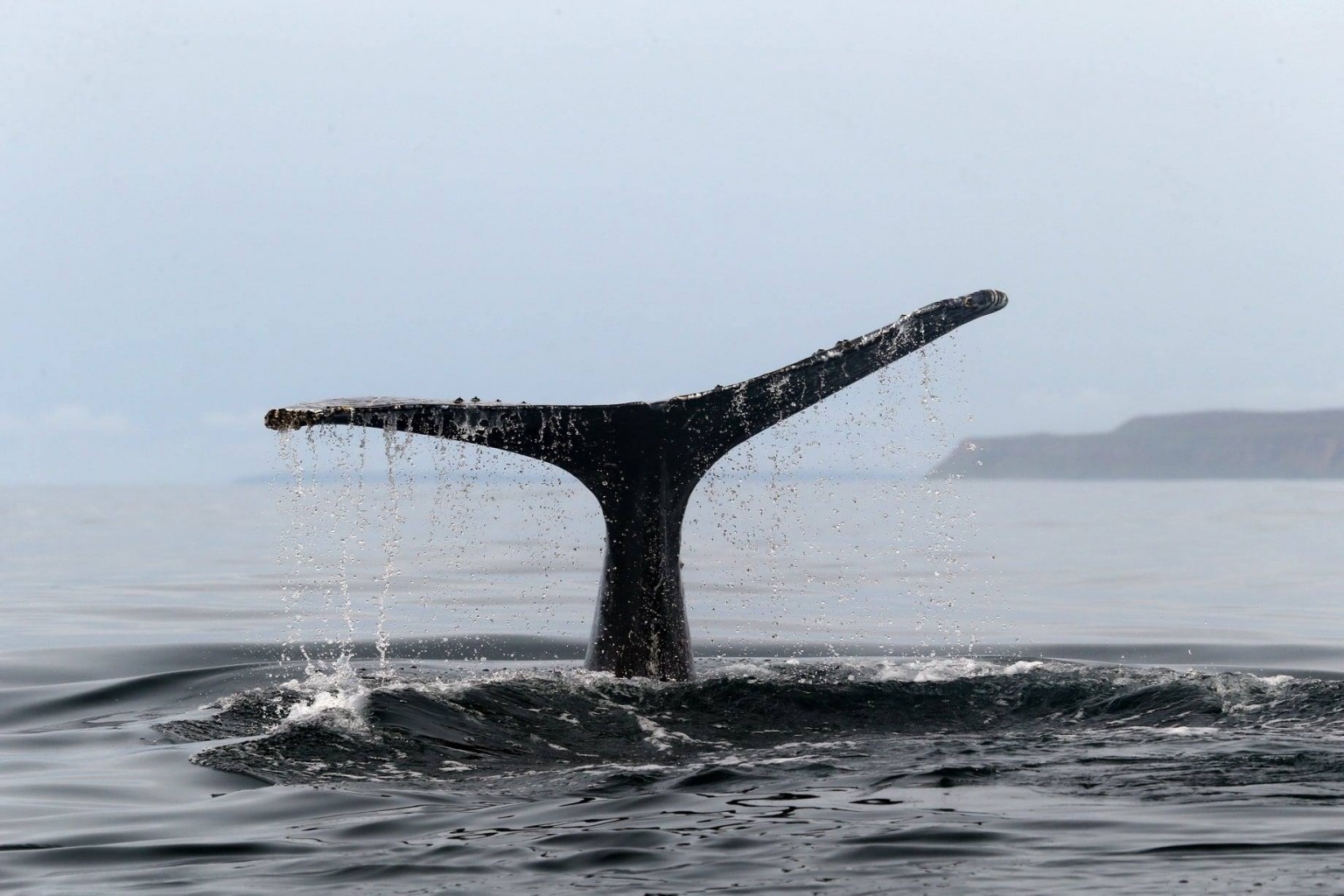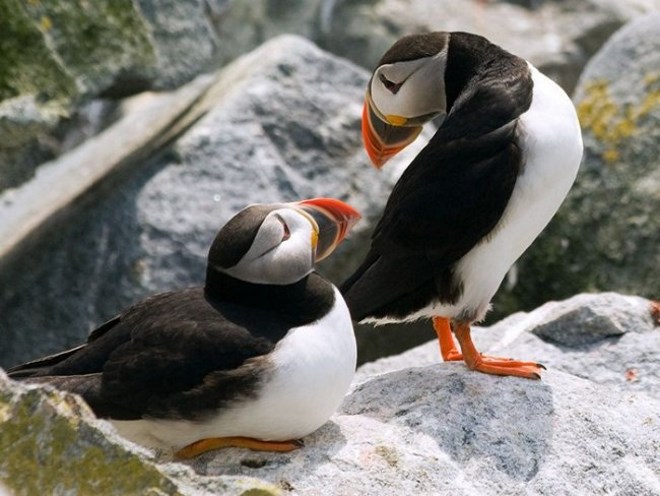
Discovered in the era of the great geographical discoveries, the Commander (Komandorskiye) Islands are a phenomenal ecosystem in the North Pacific Ocean. This natural site is literally on the edge of the earth - after all, the sea border between the Russian Federation and the USA lies between the Commander Islands and the Aleutian Islands, as well as the international date line.
All the archipelago’s vast natural-resource wealth with its picturesque rocks, sand dunes covered with a carpet of tundra, seashore colonies of birds and huge rookeries of seals and sea lions are protected undisturbed at the Komandorsky State Nature Biosphere Reserve, the largest marine reserve in Russia. Its water area is about 3.6 mn hectares - more than the area of Belgium and only slightly smaller than that of Switzerland - but the land area is very small with two relatively large and two small islands, as well as several rocks rising from the water.

In this small archipelago surrounded by the ocean where giant whales reign, you can have more adventures and experiences in a week than you could have during several years in other places. Evgeny Mamayev, Ph. D, Biology, the acting director of the Komandorsky State Nature Biosphere Reserve, told the EcoTourism Expert readers about the breathtaking beauty and grandeur of the pristine nature with its severe climate, about the main tourist attractions -for naturalists, extreme tourism enthusiasts and adventure travellers.
- The total area of the islands of the Commander archipelago is under 2,000 square kilometres. Why would the Reserve need such a large 30-mile sea area?
- The history of the protection of the Commander Islands begins in the late 19th century when the decision was taken to protect the rockeries suffering from poachers. Canadian, Japanese, American fishing trawlers set the seines in the sea, and sometimes, northern fur seals (Callorhinus ursinus) were found in the fishing nets, including female fur seals that were either on their way to breed, or left the fur seal calves on the coast and tried to find feed. Many animals died, so, it was decided to create a protected 30-mile water area around the Islands. But back then, there was no reserve. In the Soviet times, in the 1950s, a temporary convention for the preservation of fur seals was adopted, the water area was also specified, but the commercial exploitation continued. This water area was completely closed for fishing and hunting the aquatic biological resources in the 1980s, and later on, the Komandorsky Reserve was founded in 1993.
In 2002, the Reserve was included in the World Network of Biosphere Reserves within the framework of the UNESCO Man and the Biosphere (MAB) Programme. The status of a Biosphere Reserve unites specially protected natural areas (SPNAs), which in practice demonstrate the possibility of the harmonious interaction between the humans and their environments.
- The Bering Island, the largest in the Commander archipelago is ‘loaded’ with a settlement, the village of Nikolskoye, with its 718 villagers. How do you bail out of the difficulties?
- Zoning the areas helps. As a rule, there are no zones in the Russian reserves - unlike the national parks, where there is, for example, a reserved core where visitors are not allowed, the zones of the economic use where local residents can harvest firewood, collect wild herbs, hunt and fish, there are also recreational zones hosting tourists.
However, in the reserves, there is one zone where no economic activity is allowed. And just 5-10% of the area is allocated for the development of tourism, so, some mountain huts are built, trails and tourist paths are made.
But our Reserve is zoned and has a reserved core, a buffer zone open for the development of tourism, and an economic area where the economic activities of the residents are allowed, including the activities of small indigenous peoples who have been living here for centuries. The northern Aleut people live in the Aleutsky District. So, most of our Reserve, unlike others, is open for tourism.

- What is interesting about the Reserve, what attracts the travellers and tourists here?
- There are two categories of travellers - some want to visit new places, see different landscapes, while others are interested, first of all, in animals. We are proud of the biological diversity in the Reserve with its 241 species of birds, 40 species of mammals, of which 21 are cetaceans, 10 are web-footed mammals. The Reserve boasts a favorable geographic location on the migration routes of animals. For example, the northern fur seals breed on the Commander Islands, and spend the winter at about the latitude of Japan in the high seas of the Pacific Ocean. Then, they travel back. And all this migration takes place in the high seas of the ocean, including along the Kuril Island Arc. Whales also migrate and come either from the Mariana Islands, the Philippines, Hawaiian Islands, or even from Mexico.
The sea currents are an important factor that provides us with species splendor. The water in the ocean is constantly mixing, there are both surface flows and deepwater currents, the speed of the currents in the Reserve is about 2-2.5 km per hour. This allows the surface layers be enriched with deepwater substances that are the basis for the development of phytoplankton eaten by small crustaceans, and further along the food chain - by fish, birds, and cetaceans. All this attracts many animals here. And the animals attract those tourists who are keen to study all this.
The weather peculiarities are also of importance as at least 60 cyclones originating in Southeast Asia come to the Commander Islands every year. Here on the Islands, there is a zone of low atmospheric pressure and the climate changes very often. This is important not only for the animals living here, but also for the tourists.

- Do cyclones drive away the potential visitors?
- They have a significant impact on the tourist flow. You can fly to Petropavlovsk-Kamchatsky and sit and wait for a good weather for several days. Most of the cyclones intersect here, the weather can change not only every day, sometimes every hour. Very often, the weather is bad and there are no flights, the sea is stormy, and coupled with a rather poor sea communication with the islands in Kamchatka, this is a zone of risky tourism. In summer, there are 3 flying days a week on average, all depends on how lucky you are. These are the challenges one has to face when developing the ecotourism in our region.
There is no regular sea passenger service to the Reserve at all. Most of the tourists arrive by cruise ships, a smaller number of tourists arrive by tourist ships from Kamchatka. There are also thrill-seekers who come on their own. Much has changed this year, only one cruise ship came to us, but helicopter tours were more often. The tourist season shifted due to the COVID-19 quarantine and began only in August, and it was very short. We hope that the Kamchatka tour operators’ interest in the Reserve will be fueled and supported, these are our mutual interests.
- Let's talk about your animals. What inhabitants of the Reserve are now the most popular among your visitors?
- The sea otters (Enhydra) are one of the landmarks of our Reserve. They are ‘cute’ - soft, warm, and fluffy. So, we have sea otters, the ‘cutest’ animals, on the Commander Islands. They as nice as the bears, squirrels, and other continental ‘cute’ animals, especially their baby animals, which look like cuddly toys. Their furskin is like that of bears and at first, sea otter babies cannot even dive because of their fur as it collects a thick layer of air that also does not allow the kids to freeze, so they ‘float’ on the water and squeak from time to time calling their mothers to help them.

Insular seals (Phoca vitulina kurilensis) are also interesting. They are the largest among the true seals (Phocidae) and the adults can be 2 metres long. They cannot use their front limbs to crawl on land, but move like caterpillars, leaning either on the chest or on the back part of the body, which looks pretty funny. Another distinctive feature is that they do not have external ears. Half of the entire Russian population of the insular seals listed in the Red Book of the Russian Federation inhabit the Commander Islands all year round. Nine species of true seals inhabit the Island’s waters, including lionfishes (Pterois volitan), ringed seals (Phoca hispida); and even the northern elephant seals (Mirounga angustirostris) can be seen sometimes in this area, the nearest rookery of which is on the US coast, in Oregon.
- And what animals are the most numerous among web-footed mammals?
- Of course, northern fur seals (Callorhinus ursinus)! Up to 300 thousand northern fur seals gather for breeding at the Commander rockeries in summer - one fourth of the entire world population, which is about 1,2 mn individuals. In winter, only about 2 thousand males remain on the severe Commanders beaches, females with their babies go to the Pacific Ocean at the latitude of Japan. The largest reproductive rockery in the Kamchatka Territory is the Yugo-Vostochnoye (South-Eastern) one located on the Medny Island under the picturesque rocks. There are even more northern fur seals at the Northern rockery, the rocks are not very attractive there, but they are convenient to watch the animals in their natural habitat. The northern fur seals in the Reserve can be watched very close, at arm’s length.
Another interesting species, which also inhabits the Commander Islands, is the northern sea lions (Eudiscopus Eumetopias). Most of their Kamchatka population breed here. This species also listed in the Red Book of the Russian
Federation is under special protection and can be watched on our Islands. By the way, the sea lions can be seen in Petropavlovsk-Kamchatsky in winter right within the city where they move to for the winter season.
- Can whales be observed and watched here?
- The Komandorsky Nature Reserve is the only place in Russia where the observations of the cetaceans are carried out all year round. 21 species of these mammals are registered here, which makes 25% of the world population. They are not disturbed by sea vessels and poachers and live in their natural habitat practically untouched by man. Humpback whales (Megaptera novaeangliae), like a number of other animals, come here to feed. Since the oceanological situation changes from year to year, and the feeding areas shift, the cetaceans also follow them. In some years, there are more of them near the Commander Islands, along the coast of Chukotka, in other years, they are near Alaska, the Aleutian Islands. Accordingly, the situation is different every year, but in the best years, their number in our water area reaches 1,000 individuals. Up to 150-160 fountains produced by them can be observed at a time.

Killer whales (Orcinus orca) are another landmark of the Commander Islands. Two types of them can be seen here – one type feed exclusively on fish, while the others hunt marine mammals, first of all, northern fur seals. They also hunt for white-flanked porpoises (Phocoenoides dalli). Both types of the killer whales are easy to watch on the Islands. Anyone who is interested in the cetaceans should visit the Commander Islands as you can watch these majestic mammals in the wild here.
Pacific right whales (Eubalaena glacialis sieboldii) are also very interesting, this species is extremely small in number – just up to 500 individuals - and they inhabit the North Pacific Ocean only. They appear regularly in our water area, although not everyone is lucky to watch them. But the spermwhales (Physeter catodon) are much more common and can be watched.
In recent years, such a hobby as diving with whales is popular among tourists, but it requires expensive equipment and is designed for the enthusiasts, let's say. By the way, diving with whales is not allowed in some countries, for example, it is strictly prohibited in the USA. Really, this is not safe, the whales are not aggressive but their body is so great that in some cases, they can hit your head with the tail.
The cetaceans are a very unusual group of animals, our visitors are very fond of taking pictures of them, mostly of their tails and the fountains they make, and they make pictures of the humpback whales jumping, these acrobat-whales are called ‘funny whales’. A successful photoshooting requires a little bit of luck plus your good reaction plus a good-quality camera. And it is necessary that the whale makes several jumps - as a rule, no one is lucky to shoot the first jump.
- With so many birds on the Islands, perhaps, Bird Watching can be very promising ecotourism line on the Commander Islands?
- We have almost ideal conditions for Bird Watching! Annually, about 1 mn seabirds (19 species) nest here, the most numerous (500,000) are fulmars (Fulmarus glacialis), guillemots (Uria aalge) and thick-billed guillemots (Uria lomvia), as well as tufted puffins (Lunda cirrhata). The Toporkov Island got its name because of the colonies of tufted puffins (‘toporky’ in Russian), its vast plateau is dug by holes made by these amazing birds. The main colony of the tufted puffins on the Commander Islands is on the Toporkov Island, and about 100,000 birds nest here every year.

Another island is the Ariy Kamen (Ara Stone) with its cliffs covered with guillemots in their black and white ‘jackets’. Their name comes from ‘ara’, the Aleutian name for the ‘guillemot’, which imitates the sounds these birds make. In addition to the guillemots, 16 more species of seabirds nest on this Island, including auklets (Aethia cristatella), red-faced cormorants (Phalacrocorax urile). These two small islands are a real realm of birds.
The Bering Sea is the most productive in the World Ocean; in summer, up to 80 mn seabirds feed and nest here!
The Commander Islands are inhabited permanently by 60 species of birds, the remaining 180 species are migratory (appear here in spring and autumn), migrating for summer (spend summer here) and are occasional migrants brought here by revolving storms. For example, the most numerous among those birds spending summer in our water area are the Tasmanian birds (Puffinus tenuirostris), or slender-billed shearwaters, and up to 1.5 mn these birds fly here every year. They nest in Australia and Tasmania, and after breeding is complete they fly to the Commander Islands from the southern hemisphere and feed all summer here.
So, the tourists keen on birdwatching can come to admire the marvelous species. Some of them can only be seen here, and there are so many varieties of them here. For example, the red-legged kittiwakes (Rissa brevirostris), an endemic species listed in the Red Book, nest only on the Commander Islands in Russia. If you want to watch them - welcome to the Commander Islands!
There are many endemic subspecies here, too, for example, the Commander’s subspecies of the Pacific guillemot (Cepphus columba), a relative of the tufted puffins and guillemots, the ptarmigans (Lagopus mutus L.), they are not afraid of humans and allow them to come very close. The Commander Islands rosy finches (Leucosticte), the Commander Islands subspecies of wrens (Troglodytidae), the largest in Eurasia, and the Commander Islands sandpipers (Calidris). The birdwatching paradise lasts from late June to early September, for quite a long period.
- What trails are offered in the Reserve and when is it better to come to enjoy fully?
- The best time to visit the Commander Islands is from May to October and in February-March when the roads are good and there are no revolving storms. But the largest number of the animals in rookeries can be seen from July to September. The only settlement on the Commander Islands is the village of Nikolskoye on the Bering Island. The visit-centre of the Reserve is also located here. Some of the islands belong to the so-called ‘Reserved Core’, the access to it is allowed only for carrying a scientific research. The central part of the Bering Island, some areas of the Medny Island and the Toporkov Island belong to the buffer zone - you can visit them after obtaining the permission given by the Reserve’s administration. Anyone can wander around the north of the Bering Island, including visiting the two largest local rookeries of the marine mammals.
We offer a trip to the ‘world of whales’ with a boat trip along the natural scenic bays of the Bering Island, and the tours of the ‘bird islands’ - the Toporkov Island and the Ariy Kamen Island. The rookeries of the cetaceans are also important and interesting. The North-West rookery and the North one are popular, and they are completely different and complement each other. The North-West rookery allows a panoramic view, and from the viewing platforms, you can watch the ‘harem structure’ of a herd of seals, their relationships, ‘kindergartens’, and the North rookery allows you to get to the seals as close as possible.
The 110 km long hiking trail ‘Path of the Pioneers’ is for the physically fit enthusiasts. It runs through the buffer zone of the Reserve and allows you to compare the west coast and the east (Pacific) one. The travellers can enjoy the magnificent landscapes of the Bering Island, including the Steller's Arch and Mount Steller, salmons spawning, colonial-nesting seabirds in the bird colonies, partridges (Perdix perdix), polar foxes (Alopex), reindeer (Rangifer), sea otters and the insular seals.
The Commander Bay is a historical and cultural heritage site. Next year, we will celebrate the 280th anniversary of the discovery of the Commander Islands by the expedition of the famous Russian explorer Captain-Commander Vitus Bering, Dane by origin, and these islands were named after him.
On June 4, 1741, the ‘St. Peter’ small ship under the command of Vitus Bering and the ‘St. Paul’ small ship under the command of Alexei Chirikov left the Peter and Paul Harbor for the unknown coasts of America. During the Second Kamchatka Expedition, Russian America was discovered. However, the ships lost each other. Chirikov managed to return but the Bering's team was less fortunate. Scurvy broke out on their ship, and the commander fell ill, too. When the crew saw an unknown land on November 4, Bering decided to land on it. A month later, the captain-commander died of illness on this uninhabited island, part of his team also remained there forever.
The study of the new archipelago nature began from the moment the islands were discovered. The expedition included the famous naturalist George Steller who described many species of the local flora and fauna. However, very soon, the eternal human thirst for using all the riches found in nature almost brought the animals of the islands to the verge of extinction. For example, in just 27 years, Great Steller's sea cows (Hydrodamalis gigas) were completely exterminated. The animals were not afraid of people, besides, their meat was tasty. The same fate befell the Steller's flightless cormorants (Nannopterum) - large birds, which became an easy prey for people, so, it took only 100 years to exterminate this species.
The Commander islands are among the most important commercial hunting and fishing regions in the country. Here, hunting is carried out for the northern fur seals, polar foxes, sea otters, and whales in big quantities. Excessive hunting and fishing resulted in a sharp decline in the number of large cetaceans, and the sea otters were almost completely exterminated.
Fortunately, a new milestone in the history of the Commander Islands began in the 20th century. The catastrophic extermination was stopped, and now, the right to hunt here is given only to the indigenous small peoples living on the Islands who are the descendants of the Aleuts, the hunters who were once brought to the islands to work with the animals.
Today, a new stage in the history of the Commander Islands begins. We hope that the development of eco-tourism on the Island will help draw more attention to the protected areas, as well as stimulate the flow of funds for the important nature conservation work.
Photos courtesy of the Komandorsky State Nature Biosphere Reserve.
